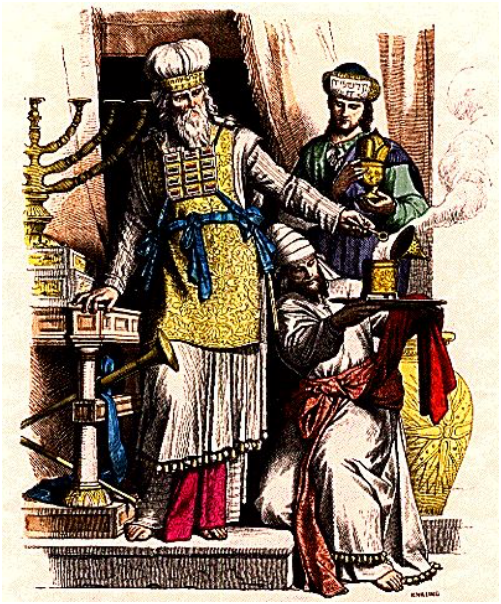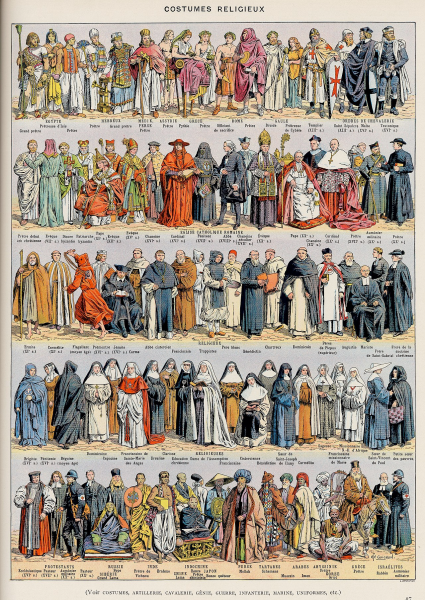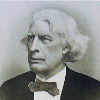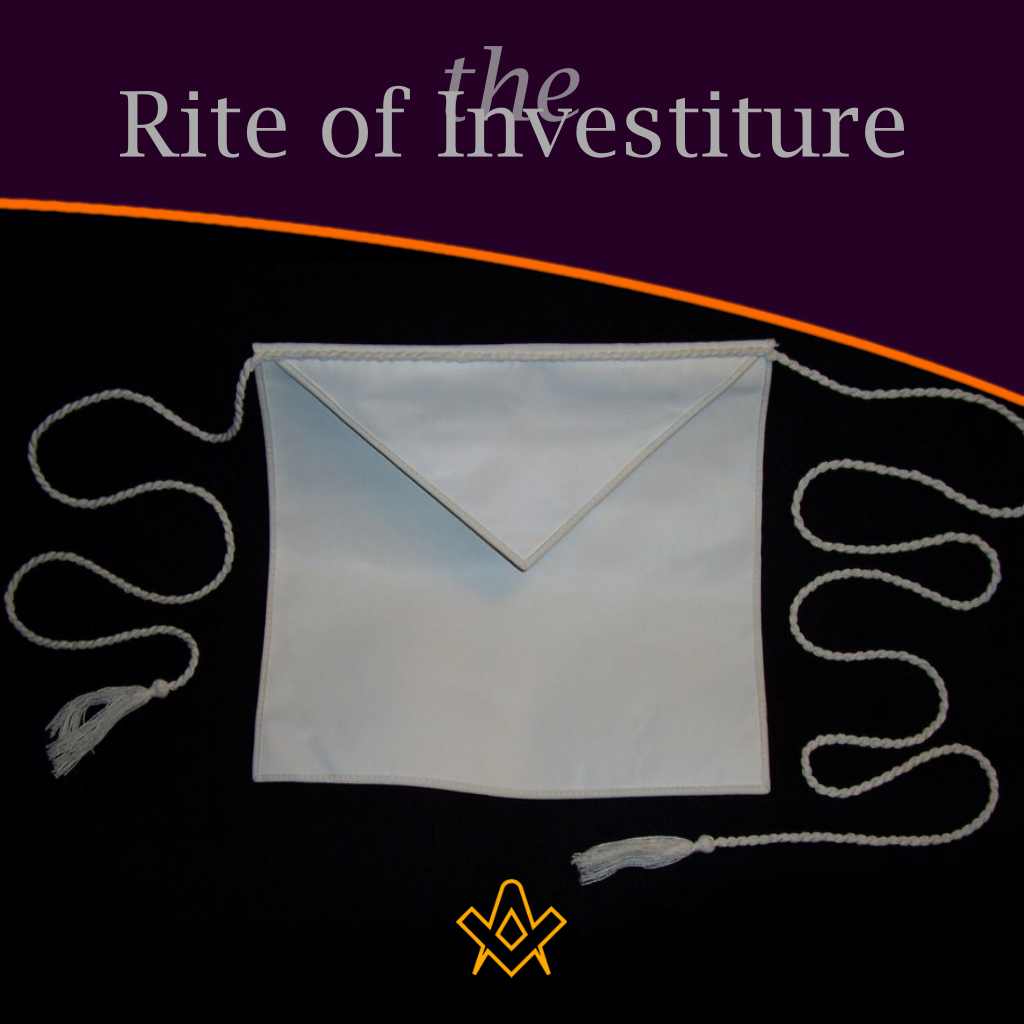Another ritualistic symbolism, of still more importance and interest, is the rite of investiture.
The rite of investiture, called, in the colloquially technical language of the order, the ceremony of clothing, brings us at once to the consideration of that well-known symbol of Freemasonry, the;
LAMB-SKIN APRON
This rite of investiture, or the placing upon the aspirant some garment, as an indication of his appropriate preparation for the ceremonies in which he was about to engage, prevailed in all the ancient initiations. A few of them only it will be requisite to consider.
Thus in the Levitical economy of the Israelites the priests always wore the abnet [sic] (correct term: avnet), or linen apron, or girdle, as a part of the investiture of the priesthood.
This, with the other garments, was to be worn, as the text expresses it, “for glory and for beauty,” or, as it has been explained by a learned commentator, “as emblematical of that holiness and purity which ever characterize the divine nature, and the worship which is worthy of him.”

The High Priest wearing the sacred vestments, the ends of the Avnet are shown in red hanging at his feet. The kohen on one knee beside him is wearing the avnet wound around his waist. ‘The History of Costume’, Braun & Schneider, Munich, 1861-1890.
IMAGE LINKED: wikimedia Attribution 4.0 International (CC BY 4.0)
In the Persian Mysteries of Mithras, the candidate, having first received light, was invested with a girdle, a crown or mitre, a purple tunic, and, lastly, a white apron.
In the initiations practised in Hindostan, in the ceremony of investiture was substituted the sash, or sacred zennaar, consisting of a cord, composed of nine threads twisted into a knot at the end, and hanging from the left shoulder to the right hip. This was, perhaps, the type of the masonic scarf, which is, or ought to be, always worn in the same position.
The Jewish sect of the Essenes, who approached nearer than any other secret institution of antiquity to Freemasonry in their organization, always invested their novices with a white robe.
And, lastly, in the Scandinavian rites, where the military genius of the people had introduced a warlike species of initiation, instead of the apron we find the candidate receiving a white shield, which was, however, always presented with the accompaniment of some symbolic instruction, not very dissimilar to that which is connected with the masonic apron.
In all these modes of investiture, no matter what was the material or the form, the symbolic signification intended to be conveyed was that of purity.
And hence, in Freemasonry, the same symbolism is communicated by the apron, which, because it is the first gift which the aspirant receives – the first symbol in which he is instructed – has been called the “badge of a mason.”
And most appropriately has it been so called; for, whatever may be the future advancement of the candidate in the “Royal Art,” into whatever deeper arcana his devotion to the mystic institution or his thirst for knowledge may carry him, with the apron–his first investiture–he never parts.
Changing, perhaps, its form and its decorations, and conveying at each step some new and beautiful allusion, its substance is still there, and it continues to claim the honorable title by which it was first made known to him on the night of his initiation.

Apron
IMAGE LINKED: wikimedia Attribution 4.0 International (CC BY 4.0)
The apron derives its significance, as the symbol of purity, from two sources–from its color and from its material. In each of these points of view it is, then, to be considered, before its symbolism can be properly appreciated.
And, first, the color of the apron must be an unspotted white. This color has, in all ages, been esteemed an emblem of innocence and purity.
It was with reference to this symbolism that a portion of the vestments of the Jewish priesthood was directed to be made white. And hence Aaron was commanded, when he entered into the holy of holies to make an expiation for the sins of the people, to appear clothed in white linen, with his linen apron, or girdle, about his loins.
It is worthy of remark that the Hebrew word LABAN, which signifies to make white, denotes also to purify; and hence we find, throughout the Scriptures, many allusions to that color as an emblem of purity. “Though thy sins be as scarlet,” says Isaiah, “they shall be white as snow;” and Jeremiah, in describing the once innocent condition of Zion, says, “Her Nazarites were purer than snow; they were whiter than milk.”

Historical religious clothing; costumes, habit, Christian, ancient Jews, liturgical, clerical, orders, monks, nuns, Asian, etc. Plate from Larousse du XXème siècle 1932.
IMAGE LINKED: wikimedia Attribution 4.0 International (CC BY 4.0)
In the Apocalypse a white stone was the reward promised by the Spirit to those who overcame; and in the same mystical book the apostle is instructed to say, that fine linen, clean and white, is the righteousness of the saints.
In the early ages of the Christian church a white garment was always placed upon the catechumen who had been recently baptized, to denote that he had been cleansed from his former sins, and was thenceforth to lead a life of innocence and purity.
Hence it was presented to him with this appropriate charge: “Receive the white and undefiled garment, and produce it unspotted before the tribunal of our Lord Jesus Christ, that you may obtain immortal life.”
The white alb still constitutes a part of the vestments of the Roman church, and its color is said by Bishop England “to excite to piety by teaching us the purity of heart and body which we should possess in being present at the holy mysteries.”
The heathens paid the same attention to the symbolic signification of this color. The Egyptians, for instance, decorated the head of their principal deity, Osiris, with a white tiara, and the priests wore robes of the whitest linen.
In the school of Pythagoras, the sacred hymns were chanted by the disciples clothed in garments of white. The Druids gave white vestments to those of their initiates who had arrived at the ultimate degree, or that of perfection.
And this was intended, according to their ritual, to teach the aspirant that none were admitted to that honor but such as were cleansed from all impurities, both of body and mind.
In all the Mysteries and religions rites of the other nations of antiquity the same use of white garments was observed.

Section from the Papyrus of Ani (The Book of Coming Forth by Day) depicting the use of white robes in a sacred ritual.
IMAGE LINKED: wikimedia Attribution 4.0 International (CC BY 4.0)
Portal, in his “Treatise on Symbolic Colors,” says that “white, the symbol of the divinity and of the priesthood, represents divine wisdom; applied to a young girl, it denotes virginity; to an accused person, innocence; to a judge, justice;” and he adds – what in reference to its use in Masonry will be peculiarly appropriate – that, “as a characteristic sign of purity, it exhibits a promise of hope after death.”
We see, therefore, the propriety of adopting this color in the masonic system as a symbol of purity. This symbolism pervades the whole of the ritual, from the lowest to the highest degree, wherever white vestments or white decorations are used.
As to the material of the apron, this is imperatively required to be of lamb-skin. No other substance, such as linen, silk, or satin, could be substituted without entirely destroying the symbolism of the vestment. Now, the lamb has, as the ritual expresses it, “been, in all ages, deemed an emblem of innocence;” but more particularly in the Jewish and Christian churches has this symbolism been observed.
Instances of this need hardly be cited. They abound throughout the Old Testament, where we learn that a lamb was selected by the Israelites for their sin and burnt offerings, and in the New, where the word lamb is almost constantly employed as synonymous with innocence.
“The paschal lamb,” says Didron, “which was eaten by the Israelites on the night preceding their departure, is the type of that other divine Lamb, of whom Christians are to partake at Easter, in order thereby to free themselves from the bondage in which they are held by vice.” The paschal lamb, a lamb bearing a cross, was, therefore, from an early period, depicted by the Christians as referring to Christ crucified, “that spotless Lamb of God, who was slain from the foundation of the world.”
The material, then, of the apron, unites with its color to give to the investiture of a mason the symbolic signification of purity. This, then, together with the fact which I have already shown, that the ceremony of investiture was common to all the ancient religious rites, will form another proof of the identity of origin between these and the masonic institution.
This symbolism also indicates the sacred and religious character which its founders sought to impose upon Freemasonry, and to which both the moral and physical qualifications of our candidates undoubtedly have a reference, since it is with the masonic lodge as it was with the Jewish church, where it was declared that “no man that had a blemish should come nigh unto the altar;” and with the heathen priesthood, among whom we are told that it was thought to be a dishonor to the gods to be served by any one that was maimed, lame, or in any other way imperfect; and with both, also, in requiring that no one should approach the sacred things who was not pure and incorrupt.
The pure, unspotted lamb-skin apron is, then, in Masonry, symbolic of that perfection of body and purity of mind which are essential qualifications in all who would participate in its sacred mysteries.
The Symbolism of Freemasonry, Chapter XIX
by Albert G. Mackey [1882]

Book Intro – The Symbolism of Freemasonry
Introduction to a classic masonic book; The Symbolism of Freemasonry: Illustrating and Explaining Its Science and Philosophy, its Legends, Myths and Symbols by Albert Mackey.
more….
Article by: Albert G. Mackey

Albert Gallatin Mackey (1807 – 1881) was an American medical doctor and author.
He is best known for his books and articles about freemasonry, particularly the Masonic Landmarks.
In 1849 he established The Southern and Western Masonic Miscellany, a weekly masonic magazine.
He served as Grand Lecturer and Grand Secretary of The Grand Lodge of South Carolina, as well as Secretary General of the Supreme Council of the Ancient and Accepted Scottish Rite for the Southern Jurisdiction of the United States
Recent Articles: symbolism
 Legends and Symbols in Masonic Instruction Explore the significance of Masonic legends and symbols in this insightful post. Discover how Freemasonry imparts wisdom through allegorical narratives and emblematic imagery, revealing profound moral and philosophical lessons. Unveil the deep connections between Masonic teachings and the broader quest for understanding life’s fundamental questions. |
 Discover the mystical significance of the number 33. From its mathematical marvels and artistic influence in numerology to its esteemed place in Freemasonry, delve into the history and power of this master number. Explore why 33 holds such profound meaning in various spiritual and philosophical traditions. |
 The Practice of Freemasonry - P1 Embark on a transformative journey with Freemasonry, where the exploration of your Center unlocks the Perfect Ashlar within. Through the practices of Brotherly Love, Relief, Truth, and Cardinal Virtues, discover a path of enlightenment and self-improvement. Embrace the universal creed that binds us in the pursuit of our true essence. |
 Discover the fascinating history and significance of the Warrant of Constitution within Freemasonry. Unveil the evolution of this crucial authorization, its role in legitimizing Lodges, and its lasting impact on the global brotherhood of Freemasons. Explore the intricate link it provides between tradition and modern practice. |
 Freemasonry: Unravelling the Complexity of an Influential Organization Mysterious and captivating, Freemasonry has piqued the interest of seekers and skeptics alike. With its intricate blend of politics, esotericism, science, and religion, this enigmatic organization has left an indelible mark on society. Prepare to delve into the secrets of Freemasonry and unlock its hidden depths. |
 Unlocking the Mysteries of Freemasonry: In the hallowed halls of Freemasonry, a powerful symbol lies at the heart of ancient rituals and teachings—the Volume of the Sacred Law. This sacred book not only guides the spiritual and moral journey of Freemasons but also serves as a beacon of universal wisdom and enlightenment. |
 The Ancient Liberal Arts in Freemasonry Embark on a journey of self-improvement and wisdom with Freemasonry's guiding principles. Ascend the winding stairs of moral cultivation, analytical reasoning, and philosophical understanding. Embrace arithmetic's mystical properties and geometry's universal truths. Let the harmony of the universe inspire unity and growth. Discover the profound, hidden knowledge in Freemasonry's path to enlightenment. |
 Initiation rituals around the world are filled with fascinating elements and different images. One of them is that of darkness. When societies speak of darkness, they often mean a lack of knowledge, a lack of choice, or a symbol of evil. During initiation rituals, darkness is used to represent the initiate's lack of knowledge about the world, society, and initiation in general. It can also represent the initiate's inability to make a choice or endure a situation. Whether you have participated in an initiation rite or not, the meaning of darkness remains an intriguing concept worth exploring. Initiation rituals around the world are filled with fascinating elements and different images. One of them is that of darkness. When societies speak of darkness, they often mean a lack of knowledge, a lack of choice, or a symbol of evil. During initiation rituals, darkness is used to represent the initiate's lack of knowledge about the world, society, and initiation in general. It can also represent the initiate's inability to make a choice or endure a situation. Whether you have participated in an initiation rite or not, the meaning of darkness remains an intriguing concept worth exploring. |
 Masonic Deacon rods potentially trace their origins to Greek antiquity, symbolically linked to Hermes' caduceus. As Hermes bridged gods and mortals with messages, so do Masonic Deacons within the lodge, reinforcing their roles through ancient emblems. This connection underscores a profound narrative, weaving the fabric of Masonic rites with the threads of mythological heritage, suggesting the rods are not mere tools but bearers of deeper, sacred meanings that resonate with the guardianship and communicative essence of their divine counterpart, Hermes, reflecting a timeless lineage from myth to Masonic tradition. |
 The biblical pillars erected by Solomon at the Temple's porch, hold a profound place in history. These brass behemoths are not mere decorations; they are symbols of strength, establishment, and divine guidance. Explore their fascinating construction, dimensions, and the deep meanings they carry in both biblical and Masonic contexts. |
 Unlocking the Mind's Potential: Dive deep into ground breaking research revealing how simple daily habits can supercharge cognitive abilities. Discover the untapped power within and redefine your limits. Join us on this enlightening journey and transform your world! |
 Dive deep into the symbolic importance of the trowel in Masonry, representing unity and brotherly love. From its historical roots in operative masonry to its significance in speculative masonry, this article explores the trowel's multifaceted role. Discover its connection to the sword, the story of Nehemiah, and the Society of the Trowel in Renaissance Florence. Unravel the layers of meaning behind this enduring Masonic symbol. |
 Symbolism of The Builder's Jewel Batty Langley's "The Builder’s Jewel" (1741) is a visual masterpiece of Masonic symbolism, showcasing Langley's deep understanding of Freemasonry. The frontispiece highlights key symbols like the three pillars and the legend of Hiram Abiff, emphasizing Langley's dedication to Masonic traditions and teachings. |
 Unveil the mystique of the colour blue in Masonic symbolism. A hue evoking universal friendship and benevolence, its roots span ancient cultures, infusing Freemasonry's core values. This article explores blue's profound significance, guiding Freemasons towards wisdom and spiritual enlightenment. Discover the fascinating journey of this universal symbol. |
 Discover the intriguing world of the plumb in Masonic symbolism with our in-depth analysis. Uncover its rich history, moral teachings, and significance in Freemasonry, guiding members on their path to truth, integrity, and justice. Immerse yourself in the captivating power of this symbol that shapes lives within the brotherhood. |
 Unlock the mysteries of Freemasonry with 'The Key,' a profound Masonic symbol. This seemingly simple instrument holds a deeper meaning, teaching virtues of silence and integrity. Explore its ancient roots, from Sophocles to the mysteries of Isis, and discover how it symbolizes the opening of the heart for judgment. |
 Unlock the secrets of the Freemasonry with The Blazing Star - a symbol that holds immense significance in their rituals and practices. Delve into its history, meaning and role in the different degrees of Freemasonry with expert insights from the Encyclopedia of Freemasonry by Albert Mackey. Discover the mystique of The Blazing Star today! |
 There is no symbol more significant in its meaning, more versatile in its application, or more pervasive throughout the entire Freemasonry system than the triangle. Therefore, an examination of it cannot fail to be interesting to a Masonic student. Extract from Encyclopedia of Freemasonry by Albert Mackey |
 The Hiramic Legend and the Myth of Osiris Hiram Abiff, the chief architect of Solomon’s Temple, is a figure of great importance to Craft Freemasonry, as its legend serves as the foundation of the Third Degree or that of a Master Mason. He is the central figure of an allegory that has the role of teaching the Initiate valuable alchemical lessons. Although his legend is anchored in biblical times, it may have much older roots. |
 This rite of investiture, or the placing upon the aspirant some garment, as an indication of his appropriate preparation for the ceremonies in which he was about to engage, prevailed in all the ancient initiations. Extract from The Symbolism of Freemasonry by Albert G. Mackey |
 The All-Seeing Eye of God, also known as the Eye of Providence, is a representation of the divine providence in which the eye of God watches over humanity. It frequently portrays an eye that is enclosed in a triangle and surrounded by rays of light or splendour. |
 What's in a Word, Sign or Token? Why do Freemasons use passwords, signs, and tokens? As Freemasons we know and understand the passwords, signs and tokens (including grips), which are all used a mode of recognition between members of the fraternity. |
 A Temple of Living Stones: Examining the Concept of a Chain of Union What are the origins of the Chain of Union? And how did they come about ? The answers may surprise some members as W Brother Andrew Hammer investigates, author of Observing the Craft: The Pursuit of Excellence in Masonic Labour and Observance. |
 One of the best loved stories for the festive season is ‘A Christmas Carol’. A traditional ghost story for retelling around the fire on a cold Christmas Eve, it is a timeless classic beloved by those from all walks of life. Philippa explores the masonic allegory connections… |
 The Trowel - Working Tool of the Master Mason The Trowel is the symbol of that which has power to bind men together – the cement is brotherhood and fellowship. |
 Two Perpendicular Parallel Lines The point within a circle embordered by two perpendicular parallel lines, with the Holy Bible resting on the circle, is one of the most recognizable symbols in Freemasonry. It is also one which always raises a question. How can two lines be both perpendicular and parallel? |
 "The first great duty, not only of every lodge, but of every Mason, is to see that the landmarks of the Order shall never be impaired." — Albert Mackey (1856) |
 It is common knowledge that the ancient wages of a Fellowcraft Mason consisted of corn, wine, and oil. |
 “Do not come any closer,” God said. “Take off your sandals, for the place where you are standing is holy ground.” Exodus 3:5 |
 The Secret Language of the Stone Masons We know of Masons' Marks but lesser known are the 'argots' used by the artisans - in part 2 of a series on the social history of the Operative Masons we learn how the use of secret languages added to the mystery of the Guilds. |
 The phrase appears in the Regius Poem. It is customary in contemporary English to end prayers with a hearty “Amen,” a word meaning “So be it.” It is a Latin word derived from the Hebrew word - Short Talk Bulletin - Vol. V June, 1927, No.6 |
 Egypt's 'Place of Truth' - The First Operative Stone Masons' Guild? Was ancient Egypt's 'village of the artisans' the first operative stone masons' guild? And was their use of 'identity marks' a forerunner of the Mason's Marks of the cathedral builders of the Middle Ages? Read on for some possible answers… |
 The Pieces of Architecture and the Origin of Masonic Study Discover the journey of the Apprentice – from Operative to Speculative. This journey has been carried out since the times of operative Freemasonry but today the initiate works in the construction of his inner temple. |
 The Builders' Rites - laying the foundations operatively and speculatively The cornerstone (also ‘foundation’ or ‘setting’ stone) is the first stone to be set in the construction of the foundations of a building; every other stone is set in reference to this. |
 Applying the working tools to achieve our peculiar system of morality. |
 We take an in-depth look at the 47th Proposition of the 1st Book of Euclid as part of the jewel of the Past Master. |
 The Cable Tow: Its Origins, Symbolism, & Significance for Freemasons - Unbinding the significance of the cable tow. |
 We examine at one of the most impressive moments of the initiatory ceremony, a certain rite known as Circumambulation, and ask what is its meaning and purpose ? |
 So, what is the Level? And why do we use it in Freemasonry? |
 What is the mysterious pigpen or Masonic cipher that has been used for centuries to hide secrets and rituals? |
 The Story of the Royal Arch - The Mark Degree Extracted from William Harvey's 'The Story of the Royal Arch' - Part 1 describes the Mark Degree, including the Working Tools. |
 Ashlars - Rough, Smooth - Story of a Stone How we can apply the rough and smooth Ashlars with-in a masonic context |
 A detailed look at the Chamber of Reflection: A Revitalized and Misunderstood Masonic Practice. |
 Exploring the origin and symbolism of Faith, Hope and Charity |
 The Noachite Legend and the Craft What is it to be a true Noachidae, and what is the Noachite Legend and the Craft ? |
 In Masonic rituals, Jacob’s ladder is understood as a stairway, a passage from this world to the Heavens. |
 What is the meaning of the Acacia and where did it originate ? |
 What is the connection with the Feasts of St John and Freemasonry |
 The Forget-Me-Not and the Poppy - two symbols to remind us to 'never forget' those who died during the two World Wars. |
 Biblical history surrounding the two pillars that stood at the entrance to King Solomon's Temple |
 Is there a direct link between Judaism and Freemasonry? |
 The symbolism of the beehive in Masonry and its association with omphalos stones and the sacred feminine. |
 The Wages of an Entered Apprentice |
 An explanation of the North East corner charge which explores beyond one meaning Charity - |
 A brief look at the origins of the two headed eagle, probably the most ornamental and most ostentatious feature of the Supreme Council 33rd Degree Ancient and Accepted (Scottish ) Rite |
 A Muslim is reminded of his universal duties just as a Freemason. A Masonic Interpretation of the Quran's First Two Chapters |
 The three Latin words -{Listen, Observe, Be Silent}. A good moto for the wise freemason |
masonic knowledge
to be a better citizen of the world
share the square with two brothers

click image to open email app on mobile device








